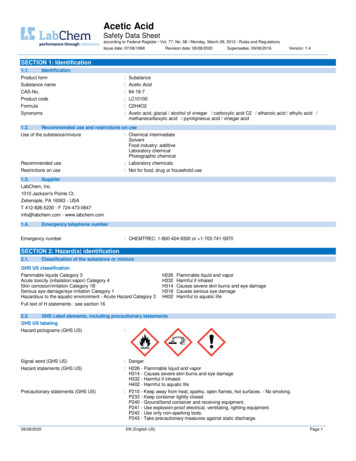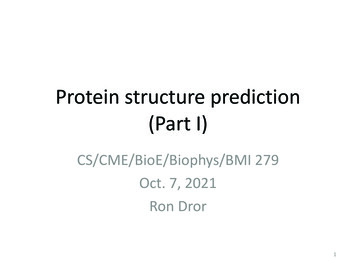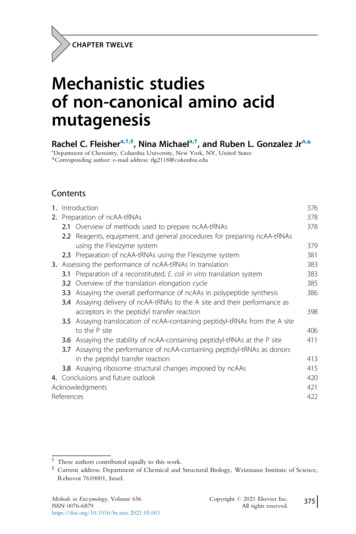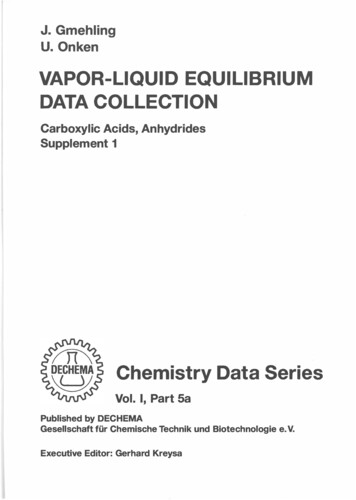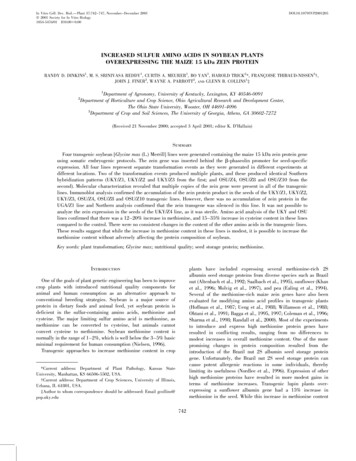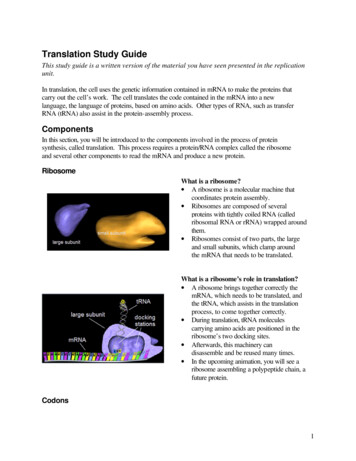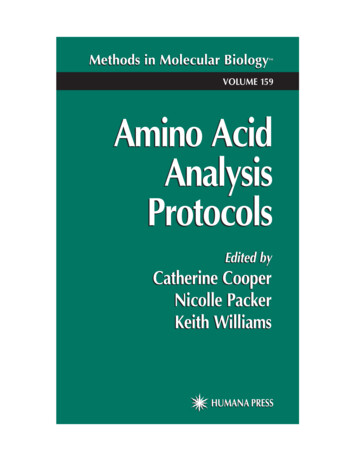
Transcription
Methods in Molecular BiologyTMVOLUME 159Amino AcidAnalysisProtocolsEdited byCatherine CooperNicolle PackerKeith WilliamsHUMANA PRESS
Amino Acid Analysis11Amino Acid AnalysisAn OverviewMargaret I. Tyler1. Importance and UtilityAmino acids are found either in the free state or as linear chains in peptidesand proteins. There are 20 commonly occurring amino acids in proteins, whichare shown in Table 1. Amino acid analysis has an important role in the study ofthe composition of proteins, foods, and feedstuffs. Free amino acids are alsodetermined in biological material, such as plasma and urine, and in fruit juiceand wine. When it is performed on a pure protein, amino acid analysis is capable of identifying the protein (2,3, and Chapter 8 in this volume), and the analysis is also used as a prerequisite for Edman degradation and mass spectrometryand to determine the most suitable enzymatic or chemical digestion method forfurther study of the protein. It is also a useful method for quantitating theamount of protein in a sample (see Chapter 2 in this volume) and can give moreaccurate results than colorimetric methods.2. Historical ViewThe earliest experiments on the acid hydrolysis of proteins were performedby Braconnot in 1820, in which concentrated sulphuric acid was used to hydrolyze gelatin, wool, and muscle fibers (4). Various reagents for performing protein hydrolysis were tried over the next 100 years, with 6 M HCl becoming themost widely accepted reagent. In 1972, Moore and Stein (5) were awarded theNobel Prize for developing an automated instrument for separation of aminoacids on an ion-exchange resin and quantitation of them using ninhydrin.More recently, high-performance liquid chromatographs (HPLCs) have beenconfigured for amino acid analysis. Some methods use postcolumn derivFrom: Methods in Molecular Biology, vol. 159: Amino Acid Analysis ProtocolsEdited by: C. Cooper, N. Packer, and K. Williams Humana Press Inc., Totowa, NJ1
2TylerTable 1Common Amino Acids3 letter1 letterEssentialforhumans sNoYesArgHisLysRHKYesYesYesProPNoSymbolNameAcidic amino acidsAspartic acidGlutamic acidNeutral amino eTryptophanTyrosineValineBasic amino acidsArginineHistidineLysineImino acidProlineatization in which the amino acids are separated on an ion-exchange columnfollowed by derivatization with ninhydrin (6, and Chapter 2 in this volume),fluorescamine (7), or o-phthalaldehyde (8). Another approach has been toderivatize amino acids prior to separation on a reversed-phase HPLC column.Examples of this technique are dansyl (9), phenylisothiocyanate (PITC) (10,and Chapters 12 and 13 of this volume), 9-fluorenylmethyl chloroformate(Fmoc) (11), and 6-aminoquinolyl-N-hydroxysuccinimyl carbamate (AQC)(12, and Chapters 4 and 8 in this volume).3. SensitivityAmino acid analysis can be performed accurately at the fmol level by methods employing fluorescence detection, whereas for derivatives detected by
Amino Acid Analysis3Table 2Comparison of Different Derivatization Chemistriesfor Amino Acid AnalysisDerivatization typeaDetection ecUVpmolr.p.precffmolr.p.precffmolr.pOPA, orthophthalaldehyde; PITC, phenylisothiocyanate; Fmoc, 9-fluorenylmethylchloroformate; AQC, 6-aminoquinolyl-N-hydroxysuccinimidyl carbamate.apostc,postcolumn; prec, precolumn.colorimetry; f, fluorescence; UV, ultraviolet.ci.e, ion exchange; r.p., reversed-phase HPLC.bc,ultraviolet (UV) light, the analysis is at the pmol level. Table 2 gives a comparison of the various derivatization chemistries and their sensitivities. Annualstudies comparing the various methods have been carried out by the Association of Biomolecular Resource Facilities (ABRF) (13,14). Strydom and Cohen(15) have compared AQC and PITC chemistries and found AQC derivatives tobe more stable.4. Difficult Amino Acids4.1. TryptophanTryptophan is destroyed in acid hydrolysis. Alkaline hydrolysis with NaOH,Ba (OH)2, or LiOH have been used particularly in the hydrolysis of food andfeedstuffs (16,17). However, acid hydrolysis is still needed to determine theother amino acids.There have been a number of methods published for the determination oftryptophan that use the standard 6 M HCl hydrolysis in the presence of additives, some of which include thioglycolic acid (18), beta-mercapto ethanol (19),and mercaptoethanesulfonic acid (20).4.2. Cysteine and CystineCysteine and cystine are unstable during acid hydrolysis, particularly in thepresence of carbohydrate. The total content of cysteine and cystine can be determined by oxidizing the protein with performic acid, which converts bothforms to cysteic acid and methionine to methionine sulphone. The protein isthen hydrolyzed with 6 M HCl (17).Disulphide compounds such as dithiopropionic acid and dithiobutyric acidhave been proposed as protecting agents for cysteine and cystine during acid
4Tylerhydrolysis (21). The use of dithiodiglycolic acid during the acid hydrolysisstep, followed by phenylisothiocyanate derivatization, allows cysteine and cystine plus all common hydrolysate amino acids (excluding tryptophan) to bedetermined (22).Reduction of disulphide bridges, followed by alkylation of cysteine withiodoacetic acid or 4-vinylpyridine is also used to determine the cysteine-pluscystine content of proteins (23). Alkylation with acrylamide produces cysteineS-propionamide, which is converted to cysteine-S-propionic acid during acidhydrolysis (24).4.3. Asparagine and GlutamineAsparagine and glutamine are amide derivatives of aspartic acid andglutamic acid, respectively. During acid hydrolysis, which cleaves amidebonds, asparagine is converted to aspartic acid and glutamine to glutamic acid.Thus, the amount determined for aspartic acid represents the total of asparticacid and asparagine and similarly for glutamic acid and glutamine.4.4. D amino AcidsThe D-amino acid content of a protein or peptide can be determined byemploying a short partial acid hydrolysis, followed by an enzymatic hydrolysiswith pronase, and then with leucine aminopeptidase and peptidyl-D-amino acidhydrolase (25).5. Modified Amino AcidsPhosphorylated amino acids are able to be analyzed using a variety of different chemistries (26), but the ABRF 1993 study found that precolumn methodswere more successful (27). Phosphoserine (28,29), phosphothreonine (29), andphosphotyrosine (29) have varying stabilities. Highest recoveries forphosphoserine and phosphotyrosine are produced with hydrolysis time of 60min or less at 110ºC, whereas for phosphothreonine, a hydrolysis time of 2 hgave better results (26). Chapter 14 in this volume covers the analysis ofphosphoamino acids more extensively.There are many other rarer amino acids and derivatives that can be analyzed.These include hydroxyproline (17,30, and Chapter 16 in this volume) andhydoxylysine (17,30, and Chapter 2 of this volume), found in collagen. Taurinehas dietary importance and can be readily determined in infant formulas, petfood, plasma, urine, and tissue extracts (17, and Chapter 10 of this volume).Posttranslational modifications, including glycosylated amino acids (31, andChapters 2 and 7 of this volume) and glycated amino acids (32,33), are important in studying protein function. Chapter 18 of this volume describes the application of mass spectrometry to the analysis of glycated amino acids.
Amino Acid Analysis56. Limitations—Contaminants and PrecautionsThe accuracy of amino acid analysis is very dependent on the integrity of thesample. Cleanliness of all surfaces the sample contacts is essential, as is thepurity of all reagents used. Traces of salts, metals, or detergents can effect theaccuracy of results.The hydrolysis step is particularly important, as was demonstrated in theABRF 1994 AAA collaborative study (34). Many laboratories now satisfactorily perform a 1-h hydrolysis in 6 M HCl at 150 C under vacuum. The traditional method uses 6 M HCl for 20–24 h at 110 C under vacuum. Losses ofserine, threonine, and to a lesser extent, tyrosine may occur under these conditions. During acid hydrolysis, some amide bonds between aliphatic amino acids are more difficult to cleave. The Ala–Ala, Ile–Ile, Val–Val, Val–Ile, Ile–Val,and Ala–Val linkages are resistant to hydrolysis and may need a longer hydrolysis time of 48 or 72 h at 110ºC (35).References1. Encyclopaedia of Food Science Food Technology and Nutrition, vol. 1 (Macrae, R.,Robinson, R. K., and Sadler, M. J., eds.), Academic, London, p. 149.2. Hobohm, U., Houthaeve, T., and Sander, C. (1994) Amino acid analysis and proteindatabase compositional search as a rapid and inexpensive method to identify proteins. Anal. Biochem. 222, 202–209.3. Schegg, K. M., Denslow, N. D., Andersen, T. T., Bao, Y. A., Cohen, S. A., Mahrenholz,A. M., and Mann, K. (1997) Quantitation and identification of proteins by aminoacid analysis: ABRF-96 collaborative trial, in Techniques in Protein Chemistry VIII(Marshak, D., ed.), Academic, San Diego, CA, pp. 207–216.4. Braconnot, H. (1820) Ann. Chim. Phys. 13, 113.5. Moore, S. and Stein, W. H. (1963) Chromatographic determination of amino acidsby the use of automatic recording equipment, in Methods in Enzymology, vol. 6(Colowick, S. P. and Kaplan, N. O., eds.), Academic, New York, pp. 819–831.6. Samejima, K., Dairman, W., and Udenfriend, S. (1971) Condensation of ninhydrinwith aldehydes and primary amines to yield highly fluorescent ternary products. 1.Studies on the mechanism of the reaction and some characteristics of the condensation product. Anal. Biochem. 42, 222–236.7. Stein, S., Bohlen, P., Stone, J., Dairman, W., and Udenfriend, S. (1973) Amino acidanalysis with fluorescamine at the picomole level. Arch. Biochem. Biophys. 155,202–212.8. Roth, M. (1971) Fluorescence reaction for amino acids. Anal. Chem. 43, 880–882.9. Tapuhi, Y., Schmidt, D. E., Lindner, W., and Karger, B. L. (1981) Dansylation ofamino acids for high-performance liquid chromatography analysis. Anal. Biochem.115, 123–129.10. Bidlingmeyer, B. A., Cohen, S. A., and Tarvin, T. (1984) Rapid analysis of aminoacids using pre-column derivatisation. J. Chromatog. 336, 93–104.
6Tyler11. Haynes, P. A., Sheumack, D., Kibby, J., and Redmond, J. W. (1991) Amino acidanalysis using derivatisation with 9-fluorenylmethyl chloroformate and reversedphase high performance liquid chromatography. J. Chromatog. 540, 177–185.12. Strydom, D. J. and Cohen, S. A. (1993) in Techniques in Protein Chemistry IV(Angeletti, R. H., ed.), Academic, San Diego, CA, pp. 299–307.13. Marenholz, A. M., Denslow, N. D., Andersen, T. T., Schegg, K. M., Mann, K.,Cohen, S. A., et al. (1996) Amino acid analysis — recovery from PVDF membranes: ABRF-95AAA collaborative trial, in Techniques in Protein Chemistry VII(Marsak, D. R., ed.), Academic, San Diego, CA, pp. 323–330.14. Tarr, G. E., Paxton, R. J., Pan, Y. C.-E, Ericsson, L. H., and Crabb, J. W. (1991)Amino acid analysis 1990: the third collaborative study from the association ofbiomolecular resource facilities (ABRF) in Techniques in Protein Chemistry II(Villafranca, J. J., ed.), Academic, San Diego, CA, pp. 139–150.15. Strydom, D. J. and Cohen, S. A. (1994) Comparison of amino acid analyses byphenylisothiocyanate and 6-aminoquinolyl-N-hydroxysuccinimyl carbamateprecolumn derivatisation. Anal. Biochem. 222, 19–28.16. Delhaye, S. and Landry, J. (1986) High-performance liquid chromatography andultraviolet spectrophotometry for quantitation of tryptophan in barytic hydrolysates. Anal. Biochem. 159, 175–178.17. Cohen, S. A., Meys, M., and Tarvin, T. L. (1988) The PicoTag Method. A Manual ofAdvanced Techniques for Amino Acid Analysis. Waters Chromatography Division,Millipore Corp., Milford, MA.18. Yokote, Y., Murayama, A., and Akahane, K. (1985) Recovery of tryptophan from25-minute acid hydrolysates of protein. Anal. Biochem. 152, 245–249.19. Ng, L. T., Pascaud, A., and Pascaud, M. (1987) Hydrochloric acid hydrolysis ofproteins and determination of tryptophan by reversed-phase high-performance liquid chromatography. Anal. Biochem. 167, 47–52.20. Yamada, H, Moriya, H., and Tsugita, A. (1991) Development of an acid hydrolysismethod with high recoveries of tryptophan and cysteine for microquantities of protein. Anal. Biochem. 198, 1–5.21. Barkholt, V. and Jensen, A. L. (1989) Amino acid analysis: determination of cysteine plus half-cystine in proteins after hydrochloric acid hydrolysis with a disulphidecompound as additive. Anal. Biochem. 177, 318–322.22. Hoogerheide, J. G. and Campbell, C. M. (1992) Determination of cysteine plushalf-cystine in protein and peptide hydrolysates: use of dithiodiglycolic acid andphenylisothiocyanate derivatisation. Anal. Biochem. 201, 146–151.23. Inglis, A. S. (1983) Single hydrolysis method for all amino acids, including cysteine and tryptophan, in Methods in Enzymology, vol. 91. Academic, San Diego,CA, pp. 26–36.24. Yan, J. X., Kett, W. C., Herbert, B. R., Gooley, A. A., Packer, N. H., and Williams,K. L. (1998) Identification and quantitation of cysteine in proteins separated by gelelectrophoresis. J. Chromatog. 813, 187–200.
Amino Acid Analysis725. D’Aniello, A., Petrucelli, L., Gardner, C., and Fisher, G. (1993) Improved methodfor hydrolysing proteins and peptides without introducing racemization and fordetermining their true D-amino acid content. Anal. Biochem. 213, 290–295.26. Yan, J. X., Packer, N. H., Gooley, A. A., and Williams, K. L. (1998) Protein phosphorylation: technologies for the identification of phosphoamino acids. J.Chromatog. A. 808, 23–41.27. Yüksel, K. Ü., Andersen, T. T., Apostol, I., Fox, J. W., Crabb, J. W., Paxton, R. J.,and Strydom, D. J. (1994) Amino acid analysis of phospho-peptides: ABRF-93AAA,in Techniques in Protein Chemistry V (Crabb, J. W., ed.), Academic, San Diego,CA, pp. 231–240.28. Meyer, H. E., Swiderek, K., Hoffmann-Posorske, E., Korte, H., and Heilmeyer, L.M., Jr. (1987) Quantitative determination of phosphoserine by high-performanceliquid chromatography as the phenylthiocarbamyl-S-ethylcysteine. Application topicomolar amounts of peptides and proteins. J. Chromatog. 397, 113–121.29. Ringer, D. P. (1991) Separation of phosphotyrosine, phosphoserine andphosphothreonine by high-performance liquid chromatography, in Methods in Enzymology, vol. 201. Academic, San Diego, CA, pp. 3–10.30. Waters AccQ.Tag Amino Acid Analysis System Operators Manual (1993). MilliporeCorp., Melford, MA.31. Packer, N. H., Lawson, M. A., Jardine, D. R., Sanchez, J. C., and Gooley, A. A.(1998) Analyzing glycoproteins separated by two-dimensional gel electrophoresis.Electrophoresis 19, 981–988.32. Walton, D. J. and McPherson, J. D. (1987) Analysis of glycated amino acids byhigh-performance liquid chromatography of phenylthiocarbamyl derivatives. Anal.Biochem. 164, 547–553.33. Cayot, P. and Tainturier, G. (1997) The quantitation of protein amino groups by thetrinitrobenzenesulfonic acid method: a reexamination. Anal. Biochem. 249, 184–200.34. Yüksel, K. Ü., Andersen, T. T., Apostol, I., Fox, J. W., Crabb, J. W., Paxton, R. J.,and Strydom, D. J. (1994) The hydrolysis process and the quality of amino acidanalysis: ABRF-94AAA collaborative trial, in Techniques in Protein Chemistry VI(Crabb, J. W., ed.), Academic, San Diego, CA, pp. 185–192.35. Ozols, J. (1990) Amino acid analysis, in Methods in Enzymology, vol. 182. Academic, San Diego, CA, pp. 587–601.
Role of AAA in a Biotechnology Laboratory92Amino Acid Analysis, Using Postcolumn NinhydrinDetection, in a Biotechnology LaboratoryFrank D. Macchi, Felicity J. Shen, Rodney G. Keck,and Reed J. Harris1. IntroductionAlthough lacking the speed and sensitivity of more widely heralded techniques such as mass spectrometry, amino acid analysis remains an indispensable tool in a complete biotechnology laboratory responsible for the analysis ofprotein pharmaceuticals.Moore and Stein developed the first automated amino acid analyzer, combining cation–exchange chromatographic separation of amino acids withpostcolumn ninhydrin detection (1). Commercial instruments based on thisdesign were introduced in the early 1960s, though many manufacturers haveabandoned this technology in favor of precolumn amino acid derivatizationwith separations based on reversed-phase chromatography (2–4) (see Note 1).In our product development role, we still rely on amino acid analysis to generate key quantitative and qualitative data. Amino acid analysis after acid hydrolysis remains the best method for absolute protein/peptide quantitation, limited inaccuracy and precision only by sample handling. We produced an Excel macro toprocess these data; the macro transfers and converts the amino acid molar quantities into useful values such as composition (residues per mol) and concentration. In addition, we employ several specialized amino acid analysis applicationsto monitor structural aspects of some of our recombinant products.De novo biosynthesis of leucine in bacteria will lead to a minor amount ofnorleucine (Nle) production (5), particularly if recombinant proteins are producedin fermentations that have been depleted of leucine (6). The side-chain of Nle(-CH2-CH2-CH2-CH3) is similar enough to methionine (-CH2-CH2-S-CH3) thatsome of the tRNAMet will be acylated by Nle, leading to incorporation of Nle atFrom: Methods in Molecular Biology, vol. 159: Amino Acid Analysis ProtocolsEdited by: C. Cooper, N. Packer, and K. Williams Humana Press Inc., Totowa, NJ9
10Macchi et al.Met positions (6,7). When this occurs, Nle may be incorporated at a low levelat every Met position, and amino acid analysis is often the only method able todetect this substitution.Hydroxylysine (Hyl) is a common modification of lysine residues found at-Lys-Gly- positions in collagens and collagen-like domains of modular proteins (8). This modification is also found at certain solvent-accessible -Lys-Glysites in noncollagenous proteins, usually at substoichiometric levels (9). Aminoacid analysis is a useful screening technique for the identification of Hyl-containing recombinant proteins produced by mammalian cells.The analysis of recombinant proteins using carboxypeptidases may still berequired to assign the C-terminus when the polypeptide chain is extensivelymodified, thus ruling out making a C-terminal assignment based solely on massand N-terminal analyses, or in cases where the C-terminal peptide cannot beassigned in a peptide map. When carboxypeptidase analyses are needed, amodified amino acid analysis program is needed to resolve Gln and Asn (whichare not found in acid hydrolysates) from other amino acids.Assignment of Asn-linked glycosylation sites is greatly facilitated by priorknowledge of the -Asn-Xaa-Thr/Ser/Cys- consensus sequence sites (10), andspecific endoglycosidases, such as peptide:N-glycosidase F can be employedto quantitatively release all known types of Asn-linked oligosaccharides (11).O-linked sites are harder to assign, as these are found in less-stringent sequencemotifs (12–14), and there is no universal endoglycosidase for O-glycans exceptfor endo-α-N-acetylgalactosaminidase, which can only release the disaccharideGal(β1 3)GalNAc. In addition, O-glycosylation is often substoichiometric.In mammalian cell products, at least two N-acetylglucosamine (GlcNAc)residues are found in Asn-linked oligosaccharides, whereas N-acetylgalactosamine (GalNAc) is found at the reducing terminus of the most common(mucin-type) O-linked oligosaccharides. A cation–exchange-based amino acidanalyzer can easily be modified for the analysis of the amino sugars glucosamine (GlcNH2) and galactosamine (GalNH2) from acid hydrolysis ofGlcNAc and GalNAc, respectively, allowing confirmation of the presence ofmost oligosaccharide types. In glycoproteins, HPLC fractions from peptidedigests can be screened using amino sugar analysis to identify glycopeptidesfor further analysis.Regulated biotechnology products are usually tested for identity using HPLCmaps after peptide digestion (15,16). A key aspect of the digestion step formost proteins is obtaining complete reduction of all disulfide bonds, followedby complete alkylation of cysteines without the introduction of artifacts (e.g.,methionine S-alkylation) (17). Amino acid analysis can be used to monitorcysteine alkylation levels for reduced proteins, such as are obtained after alkylation with iodoacetic acid, iodoacetamide or 4-vinylpyridine.
Role of AAA in a Biotechnology Laboratory112. Materials2.1. Equipment1. 1-mL hydrolysis ampoules (Bellco, Vineland, NJ; part number 4019-00001) (seeNote 2).2. Savant SpeedVac.3. Oxygen/methane flame.4. Glass knife (Bethlehem Apparatus Co., Hellertown, PA).5. 1/4" ID 5/8" OD Tygon tubing.6. Model 6300 analyzers (Beckman Instruments, now Beckman Coulter, FullertonCA). The sum of the 440 nm and 570 nm absorbances is converted to digitalformat using a PE Model 900 A/D converter, and the data are collected by a PETurbochrom Model 4.1 data system (see Notes 3–5).7. Lithium-exchange column (Beckman part number 338075, 4.6 200 mm).2.2. Reagents and Solutions1. Constant boiling (6 N) HCl ampoules are obtained from Pierce (Rockland, IL)(see Note 6).2. Mobile phase buffers purchased from Beckman Instruments include sodium citrate buffers Na-D, Na-E, Na-F, Na-R, and Na-S; lithium citrate buffers includeLi-A, Li-B, Li-C, Li-D, Li-R, and Li-S.3. Ninhydrin kits (Nin-Rx) are also purchased from Beckman; these must be mixedthoroughly before use (usually 2 h at room temperature), and care must be takento avoid skin discoloration because of contact with ninhydrin-containing materials.4. Dialysis may be used to desalt samples into dilute acetic acid prepared fromdeionized water (Milli-Q, Millipore) and Mallinckrodt U.S.P. grade glacial aceticacid.5. Amino acid standards: are diluted from the stock Beckman standard (part number 338088) with Na-S buffer to final concentration of 40 nmol/mL or 20 nmol/mL (see Note 7).6. 2 N glacial acetic acid.3. Methods3.1. Sample PreparationProteins should be desalted to obtain optimal compositional data. Dialysisagainst 0.1% acetic acid removes salts while keeping proteins in solution, butquantitative data will often require direct hydrolysis (i.e., without dilution orsample losses introduced during dialysis). When proteins must be analyzedwithout desalting, neutral buffers such as 50 mM Tris can be used withoutcompromising the results. Excipients to avoid include urea (which generatesabundant ammonia during hydrolysis), sugars (which caramelize duringhydrolysis), and detergents such as the polysorbate and Triton types that can
12Macchi et al.Table 1Standard Amino Acid AnalysisTime nditionsSample injectionStart temp. gradientBuffer changeBuffer changeReagent pumpBuffer changeBuffer changeTemperature changeReagent pumpRecyle (start next run)Na-E buffer, 48 C48 C to 60 C in 8 minNa-E to Na-FNa-F to Na-DNinhydrin to waterNa-D to Na-RNa-R to Na-E60 C to 48 CWater to ninhydrinBuffer pump: 16 mL/h.Reagent pump: 8 mL/h.damage cation–exchange columns. Samples in enzyme-linked immunosorbent assays (ELISA)-type buffers should be avoided as they typically containalbumin or gelatins, whose amino acids cannot be distinguished after hydrolysis from the protein of interest. Peptides generally can be desalted by reverse phase (RP)-HPLC using volatile solvents such as 0.1% TFA in water/acetonitrile.1. Place samples in hydrolysis ampoules (see Note 8), then dry under vacuum usinga Savant SpeedVac.2. Place approx 100 µL of 6 N HCl in the lower part of the ampoule (see Note 9).Freeze in a dry ice/ethanol bath, attached to a vacuum system via 1/4" ID 5/8" OD Tygon tubing, then slowly thaw and evacuate to 150 mtorr.3. Use an oxygen/methane flame to seal the neck of the tube at the constriction.4. Place the sealed ampoules in a 110 C oven for 24 h (see Note 10), then allow tocool before opening after scoring them with a glass knife.5. Remove the acid by vacuum centrifugation, again using a Savant system, with aNaOH trap inserted between the centrifuge and cold trap.6. After hydrolysis and acid removal, samples that contain 0.5–10 µg of protein, or0.1–1 nmol of peptide fractions should be reconstituted with 60–200 µL of Na-Ssample buffer (see Note 11).3.2. Protein/Peptide Quantitation1. Subject triplicate samples containing 0.5–10 µg of protein or 0.1–1 nmol of peptide to 24-h hydrolysis in vacuo as aforementioned.2. Follow the standard operating conditions given in Table 1 (see Note 12). A standard chromatogram containing 2 nmol of each component is shown in Fig. 1.
Role of AAA in a Biotechnology Laboratory13Fig. 1. Analysis of a standard amino acid mixture. The standard contains 2 nmol ofeach component except for NH3. Operating parameters are given in Table 1.3. Peak area data from the Turbochrom system are converted to nmol values byexternal standard calibration; internal standards are not necessary if a reliableautosampler is used.4. The amino acid nmol values are also automatically converted to .tx0 files thatcan be imported into a custom Microsoft Excel program called the AAA MACRO(Table 2) for analysis using a PC-based computer.5. The first step in running the AAA MACRO is to open a template, such as theexample “protein.xls” given in Table 3. The residues per mol and molecular masscalculations must be modified and saved for each different protein/peptide; Asnand Asp are reported as Asx, whereas Gln, Glu and pyroglutamate are reported asGlx.6. The macro asks for some background information (e.g., requestor’s name, samplename, number of replicates), sample prep information (e.g., volumes of hydrolysate loaded vs reconstitution volume, original sample volume), then processesthe data, providing a single-page report showing calculated compositions andconcentration, as shown in Fig. 2 (see Note 13–15).3.3. Norleucine Incorporation1. Detection of trace Nle levels in Escherichia coli-derived proteins require 24-hhydrolysis of 25–100 µg of protein (see Note 16).
14Table 2Amino Acid Analysis Data Conversion MacroCommands14Asks for Requestor's NameHalts macro if Cancel button is clickedReturns name to data worksheet cell B4Asks for Requestor's ExtensionHalts macro if Cancel button is clickedReturns extension to data worksheet cell B5Asks for protein to be analyzedHalts macro if Cancel button is clickedReturns protein's name to data worksheet cell E4Asks for Requestor's MailStopHalts macro if Cancel button is clickedReturns Requestor's MailStop to data worksheet cell E5Asks for MWHalts macro if Cancel button is clickedReturns MW to data worksheet cell B28Asks for amount sample put in ampouleAsks for reconstitution volume of sampleHalts macro if Cancel button is clickedMacchi et al.Macro 4(a) ACTIVATE("MACRO4A.XLM") HIDE() \TC4\DATA SELECT(!B4) INPUT("Requestor's Name?",2,"Name","" IF(A7 FALSE,HALT()) FORMULA(A7) SELECT(!B5) INPUT("Requestor's Extension?",1,"Telephone extension","") IF(A11 FALSE,HALT()) FORMULA(A11) SELECT(!E4) INPUT("Sample to be analyzed?",2,"Sample name", "") IF(A15 FALSE,HALT()) FORMULA(A15) SELECT(!E5) INPUT("Requestor's Mail Stop?",1,"Mail Stop","") IF(A19 FALSE,HALT()) FORMULA(A19) SELECT(!B28) INPUT("Molecular Mass of protein to be analyzed?",1, "Molecular Mass (g/mole)","") IF(A23 FALSE,HALT()) FORMULA(A23) SELECT(!F29) INPUT("µL in Ampoule?",1,"Ampoule volume (µL)","") IF(A27 FALSE,HALT()) FORMULA(A27) SELECT(!F30) INPUT("Sample reconstitution volume?",1,"Reconstituted volume (µL)","") IF(A31 FALSE,HALT()) FORMULA(A31) SELECT(!F31)
Selects cell B1 on worksheetAsks how many replicate samples will be processedHalts macro if Cancel button is clickedPlaces users sample number in cell B2Resets counter1Selects active cell to be B6Selects disk in drive as AAA directoryOpens AAA diskTop of loop and Select data file from listed filesSelect data file to openCopies AAA nanomole dataCloses data filePastes nanomole values into worksheetAdds value of 1 to the counter1Checks to see what value counter1 if 1 then loops up to thetop of the loop, if 0 then proceeds downwardAsks for name of first data file chosenAsks for name of second data file chosenAsks for name of third data file chosenAsks if you want to save dataHalts macro if Cancel button is clickedHalts the macro15 SELECT(!C40) INPUT("What is the name of your first replicate?",2, "Name of 1st replicate","") IF(A56 FALSE,HALT()) FORMULA(A56) SELECT(!D40) INPUT("What is the name of your second replicate?",2, "Name of 2nd replicate","") IF(A60 FALSE,HALT()) FORMULA(A60) SELECT(!E40) INPUT("What is the name of your third replicate?",2, "Name of 3rd replicate","") IF(A64 FALSE,HALT()) FORMULA(A64) SAVE.AS?(,1) IF(A67 FALSE,HALT()) ACTIVATE("MACRO4A.XLM") UNHIDE() ACTIVATE.NEXT() RETURN()Asks if samples were diluted prior to analysisHalts macro if Cancel button is clickedRole of AAA in a Biotechnology Laboratory15 INPUT("Dilution Factor?",1,"Dilution factor","" IF(A35 FALSE,HALT()) FORMULA(A35) SELECT(!B1) INPUT("How many replicates will you be analyzing today?", 1,"Number of replicates","") IF(A39 FALSE,HALT()) FORMULA(A39) SET.NAME("counter1",1) SELECT(!B41) DIRECTORY("\TC41\data") FILES("*.*") OPEN?("*.*",0,FALSE,2) SELECT("R38C6:R57C6") COPY() CLOSE() ACTIVATE.NEXT() SELECT("RC[1]") PASTE() SET.NAME("counter1",counter1 1) IF(counter1 (B1),GOTO(A46))
Table16 3AAA Macro TemplateAAAAMacroMacchi et al.BCD3Protein TemplateName:Extension:Researcher:0Mail Stop:TheoreticalCompositionAmino AcidCyAAsxThrSerGlxPro Cys SHGlyAla1/2 Cys-CysValMetlleLeuNleTyrPheHisLysArgMolecularMass (g/mole)column load (ul)Amino AcidProtein Name:035375941243330103531232022137271247503.01ul in Ampoulesmp recon(ul)dilution factor50nMois ProteinProteinConcentrationmg/mLTheor
Amino Acid Analysis An Overview Margaret I. Tyler 1. Importance and Utility Amino acids are found either in the free state or as linear chains in peptides and proteins. There are 20 commonly occurring amino acids in proteins, which are shown in Tab le 1.

